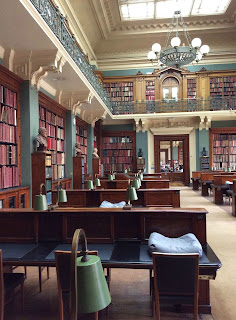Place: London
Time: 7:00 p.m.
Temperature: 24°C
Song of the evening: Eye of the Tiger by Survivor
Before I left for the UK, I had lunch with my colleague Andrew Riddle. Andrew went to King's College London and knows the city well and I was hoping for tips on what sights to see. He suggested a walk along the South Embankment (prescient!) and mentioned the London Eye but not with much enthusiasm.
 |
| Here's a shot of the London Eye I took from the north side of the Thames. The building behind the Eye houses the London aquarium. |
 |
| (Google Maps) |
Wow ... what a view!
Dr. Dave Davies, the chief factotum of our trip (i.e., the prof. responsible for the entire program, not just the library science group) was kind enough to take a photo for me as I'm not too good on selfies ... and he contributed the shot of an Eye pod (sorry, no pun intended).
I felt like I was in a very spacious, slow moving ski gondola and I highly recommend being "trapped" by the Eye.
References
Google Maps. (2015). [Stamford Street to the London Eye]. Retrieved from https://www.google.ca/maps/dir/127+Stamford+St,+London+SE1+9NQ,+UK/London+Eye,+Lambeth,+London+SE1+7PB/@51.5040672,-0.1179752,17z/data=!3m1!4b1!4m14!4m13!1m5!1m1!1s0x487604b74b8a9af9:0x54b703a8b21d032b!2m2!1d-0.111794!2d51.50543!1m5!1m1!1s0x487604b900d26973:0x4291f3172409ea92!2m2!1d-0.119543!2d51.503324!3e2
References
Google Maps. (2015). [Stamford Street to the London Eye]. Retrieved from https://www.google.ca/maps/dir/127+Stamford+St,+London+SE1+9NQ,+UK/London+Eye,+Lambeth,+London+SE1+7PB/@51.5040672,-0.1179752,17z/data=!3m1!4b1!4m14!4m13!1m5!1m1!1s0x487604b74b8a9af9:0x54b703a8b21d032b!2m2!1d-0.111794!2d51.50543!1m5!1m1!1s0x487604b900d26973:0x4291f3172409ea92!2m2!1d-0.119543!2d51.503324!3e2












































